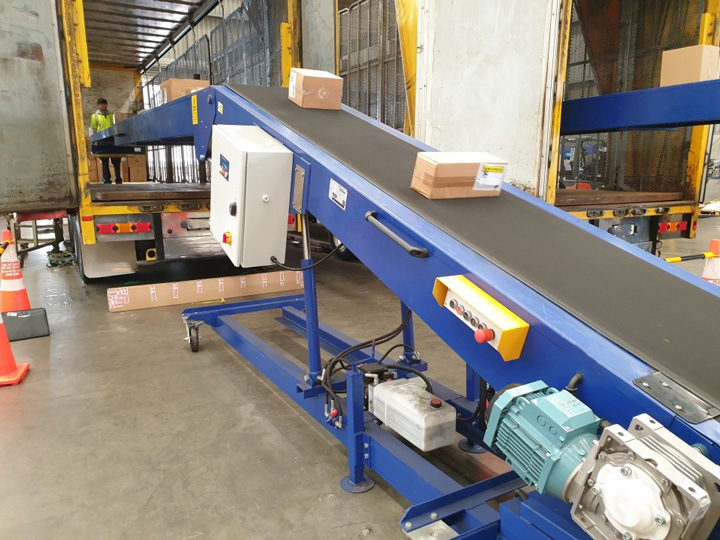A Loading Unloading Conveyor System is an integrated set of conveyors and related equipment designed specifically to facilitate the efficient, safe, and often automated transfer of goods into and out of various transport vehicles (trucks, containers, vans, railcars) or between different stages of a material handling process (e.g., from a production line to a palletizing station, or from storage to shipping).
These systems are crucial for optimizing logistics operations, reducing manual labor, preventing injuries, and improving overall throughput at loading docks, warehouses, distribution centers, and manufacturing facilities.
Key Components of a Loading Unloading Conveyor System
While specific configurations vary widely, common components include:
1.Main Conveyor Types (within the system):
Belt Conveyors: Most versatile, good for various item shapes/sizes (boxes, bags, irregular items). Can handle inclines/declines.
2.Roller Conveyors (Powered & Gravity): Excellent for flat-bottomed items like cartons, totes, pallets. Powered rollers provide controlled movement; gravity rollers are cost-effective for downhill or manual push zones.
3.Chain Conveyors: Used for heavier or bulkier items, pallets, or items with unique bases (e.g., drums, tires), providing strong, positive drive.
4.Slat Conveyors: Flat, connected slats forming a continuous surface, good for heavy, hot, or oddly shaped items.
5.Telescopic Conveyors (Extendable Conveyors):
The most common and versatile component specifically for truck/container loading/unloading. These conveyors have multiple retractable sections that can extend deep into a trailer and retract as the loading/unloading progresses.
Types: Can be belt, roller, or gravity sections. Often integrated with powered drive for both extension/retraction and product movement.
Function: Bridges the gap between the fixed dock/warehouse conveyor system and the far end of the truck/container, allowing workers to place or pick items directly onto/from the conveyor.
6.Flexible / Accordion Conveyors:
Description: Portable, expandable, and flexible conveyors (often roller or skate wheel) that can be easily bent around curves, extended, or collapsed for storage.
Function: Used for temporary setups, irregular loading dock layouts, or to quickly adapt to different truck sizes.
Dock Levelers:
Description: A mechanical or hydraulic plate at the loading dock that bridges the height difference between the dock and the truck bed, creating a seamless transition.
Function: Essential for allowing forklifts, pallet jacks, and even manual carts to safely move into and out of the truck.
Lift Tables / Scissor Lifts:
Description: Platforms that can be raised or lowered to match different truck bed heights or to adjust ergonomic working heights.
Function: Improves ergonomics for manual loading/unloading, or positions conveyors at optimal heights.
Transfer Stations / Diverters / Merges:
Description: Mechanisms that allow items to change direction, merge onto a single line, or divert to different lines (e.g., for sorting, inspection, or palletizing).
Function: Creates a dynamic and flexible material flow within the loading/unloading process.
Pallet Handling Equipment:
Pallet Dispensers: Automatically feed empty pallets into the loading area.
Pallet Stackers: Stack empty pallets.
Pallet Jacks / Forklifts: Used for moving full pallets to/from the conveyor system or into/out of trucks.
Control System:
PLCs (Programmable Logic Controllers): The “brain” that orchestrates the movement of all conveyor sections, actuators, and associated equipment.
Sensors: Photo-eyes, proximity sensors, barcode scanners, or even vision systems to detect product presence, type, and position, triggering conveyor segments or diversions.
HMI (Human Machine Interface): Touchscreen panels for operators to manage the system, select modes (load/unload), start/stop, and troubleshoot.
Applications
Loading Unloading Conveyor Systems are essential for:
1.Warehouses & Distribution Centers: High-volume inbound and outbound logistics.
2.E-commerce Fulfillment Centers: Rapid processing of diverse packages.
3.Manufacturing Plants: Moving raw materials into production or finished goods out.
4.Freight & Parcel Carriers: Fast sorting and loading/unloading of packages.
5.Retail Backrooms: Efficiently receiving and processing inventory.
By automating the loading and unloading process, businesses can significantly improve their supply chain efficiency, reduce operational costs, and create a safer working environment.

Thanks for reading! I’m Loren, responsible for the global automation equipment export business at Tongli Industrial.
We provide high-precision loading and unloading robots to help factories upgrade to intelligence.
If you need product catalog or customized solution, please contact:
Email: manipulator@tongli17.com | Mobile Phone: +86 159 5011 0267